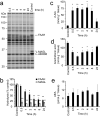Selective blockade of 2-arachidonoylglycerol hydrolysis produces cannabinoid behavioral effects
- PMID: 19029917
- PMCID: PMC2605181
- DOI: 10.1038/nchembio.129
Selective blockade of 2-arachidonoylglycerol hydrolysis produces cannabinoid behavioral effects
Abstract
2-Arachidonoylglycerol (2-AG) and anandamide are endocannabinoids that activate the cannabinoid receptors CB1 and CB2. Endocannabinoid signaling is terminated by enzymatic hydrolysis, a process that for anandamide is mediated by fatty acid amide hydrolase (FAAH), and for 2-AG is thought to involve monoacylglycerol lipase (MAGL). FAAH inhibitors produce a select subset of the behavioral effects observed with CB1 agonists, which suggests a functional segregation of endocannabinoid signaling pathways in vivo. Testing this hypothesis, however, requires specific tools to independently block anandamide and 2-AG metabolism. Here, we report a potent and selective inhibitor of MAGL called JZL184 that, upon administration to mice, raises brain 2-AG by eight-fold without altering anandamide. JZL184-treated mice exhibited a broad array of CB1-dependent behavioral effects, including analgesia, hypothermia and hypomotility. These data indicate that 2-AG endogenously modulates several behavioral processes classically associated with the pharmacology of cannabinoids and point to overlapping and unique functions for 2-AG and anandamide in vivo.
Figures








Comment in
-
Decoding endocannabinoid signaling.Nat Chem Biol. 2009 Jan;5(1):8-9. doi: 10.1038/nchembio0109-8. Nat Chem Biol. 2009. PMID: 19088712 No abstract available.
References
-
- Mackie K. Cannabinoid receptors as therapeutic targets. Annu Rev Pharmacol Toxicol. 2006;46:101–22. - PubMed
-
- Devane WA, et al. Isolation and structure of a brain constituent that binds to the cannabinoid receptor. Science. 1992;258:1946–9. - PubMed
-
- Sugiura T, et al. 2-Arachidonoylglycerol: a possible endogenous cannabinoid receptor ligand in brain. Biochemical and Biophysical Research Communications. 1995;215:89–97. - PubMed
-
- Mechoulam R, et al. Identification of an endogenous 2-monoglyceride, present in canine gut, that binds to cannabinoid receptors. Biochemical Pharmacology. 1995;50:83–90. - PubMed
-
- Di Marzo V, et al. Leptin-regulated endocannabinoids are involved in maintaining food intake. Nature. 2001;410:822–5. - PubMed
Publication types
MeSH terms
Substances
Associated data
- PubChem-Substance/56365468
- PubChem-Substance/56365469
- PubChem-Substance/56365470
- PubChem-Substance/56365471
- PubChem-Substance/56365472
- PubChem-Substance/56365473
- PubChem-Substance/56365474
- PubChem-Substance/56365475
- PubChem-Substance/56365476
- PubChem-Substance/56365477
- PubChem-Substance/56365478
- PubChem-Substance/56365479
- PubChem-Substance/56365480
- PubChem-Substance/56365481
- PubChem-Substance/56365482
- PubChem-Substance/56365483
- PubChem-Substance/56365484
- PubChem-Substance/56365485
- PubChem-Substance/56365486
- PubChem-Substance/56365487
- PubChem-Substance/56365488
- PubChem-Substance/56365489
- PubChem-Substance/56365490
- PubChem-Substance/56365491
- PubChem-Substance/56365492
- PubChem-Substance/56365493
- PubChem-Substance/56365494
- PubChem-Substance/56365495
- PubChem-Substance/56365496
- PubChem-Substance/56365497
- PubChem-Substance/56365498
- PubChem-Substance/56365499
Grants and funding
- P50 DA005274/DA/NIDA NIH HHS/United States
- DA025285/DA/NIDA NIH HHS/United States
- R01 AA014619/AA/NIAAA NIH HHS/United States
- R01 DA003672/DA/NIDA NIH HHS/United States
- P20 DA024194/DA/NIDA NIH HHS/United States
- AA014619/AA/NIAAA NIH HHS/United States
- R01 DA015683/DA/NIDA NIH HHS/United States
- DA017259/DA/NIDA NIH HHS/United States
- P01 DA017259/DA/NIDA NIH HHS/United States
- DA005274/DA/NIDA NIH HHS/United States
- DA024194/DA/NIDA NIH HHS/United States
- P50 AA006420/AA/NIAAA NIH HHS/United States
- DA007027/DA/NIDA NIH HHS/United States
- AA06420/AA/NIAAA NIH HHS/United States
- R01 DA025285/DA/NIDA NIH HHS/United States
- T32 DA007027/DA/NIDA NIH HHS/United States
LinkOut - more resources
Full Text Sources
Other Literature Sources
Chemical Information
Molecular Biology Databases

